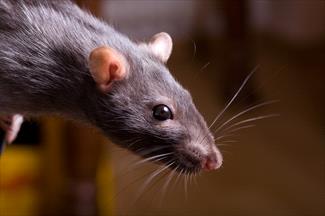The War Against Rodents
Grey Rat

Rodent control has been paramount in human civilization for centuries if not millennia. Wild rodents consume our crops, destroy our fabric and paper products, bring disease, and are generally unsanitary in our homes. Rat poisons, as well as traps, are widely used to control rodent populations in human communities all over the world.
In the past, anticoagulant rodenticides, which were effective and available in virtually every hardware and garden store, were the most common rat poisons in the U.S. residential market. These products were readily consumed by rodents, and after five days or so, they induced internal bleeding and death. Problems with them included toxicity when they were accidentally consumed by pets or by predatory wildlife. Either group of animals might consume the poisons outright or might become poisoned by eating an already intoxicated rodent. The EPA demanded that these types of poisons be phased out, and presently, they are only available to commercial exterminators. Demand for safer products rose.
Bromethalin was supposed to represent a better choice. Because only small amounts are needed to kill a rodent, a predator is unlikely to be harmed by consuming a bromethalin-poisoned rodent. This is good news for owls, hawks, and other rat-consuming wildlife. For dogs and cats, however, this is only a small advantage, as pets commonly consume the rodenticide directly. Anticoagulant rodenticides have an antidote in case of accidental poisoning, while bromethalin has none, and bromethalin products are readily palatable to dogs and cats.
With anticoagulant rodenticides becoming less available, bromethalin has captured the home rat poison market and has created a new hazard for pets to contend with.
What does Bromethalin do?
Bromethalin has been around since 1985, and it is sold as bars, blocks, and pellets to be used against rats and mice, as well as in the shape of earthworms to be used against moles. The product can be sprinkled on the ground or, for a safer presentation, provided inside a plastic bait station accessible to rodents but not to pets.
Bromethalin acts by uncoupling oxidative phosphorylation in the brain. What that means is that bromethalin makes it impossible to maintain aerobic metabolism in the brain. Oxygen cannot be used. Without the ability to use oxygen, the brain cannot make enough energy to fuel itself. The brain swells, and the victim dies of cerebral edema.
Peak levels of bromethalin are achieved a mere four hours after the poison is eaten.
What Does This Mean for a Pet?
There are two forms of poisoning recognized in pets: the high dose (or convulsant form) and the low dose (or paralytic form).
The Convulsant Form
If a high dose of bromethalin has been consumed, symptoms generally begin in a matter of hours. The patient will develop hyperexcitability followed by muscle tremors, increased body temperature, and seizures. Death is virtually inevitable.
The Paralytic Form
If a lower dose has been consumed, symptoms do not show up for one to four days. Vomiting and appetite loss result. The patient becomes weak in the rear and uncoordinated. The eyes begin to move involuntarily back and forth (nystagmus) and the pupils become unequal in size. Muscle tremors culminating in paralysis result. Treatment is still possible with this form, but it must be aggressive.
Treatment
Treatment for this poisoning must begin immediately, ideally within an hour of eating the poison. The patient is made to vomit and then must receive several doses of activated charcoal to bind any poison in the intestinal tract before the patient’s body absorbs it. Use of activated charcoal can continue for days.
Muscle contractions are treated with sedatives and muscle relaxants. Brain swelling is treated with diuretics. One study in rodents found that if rats were given ginkgo biloba immediately, their toxicity symptoms were greatly reduced but no such research has been performed in dogs or cats.
Survivors may have permanent neurologic deficits and it make take weeks for recovery to plateau so that permanent damage can be assessed. Many patients will not eat during treatment and nutritional support, such as an esophagostomy tube, must be employed.
If you use a bromethalin-based rat poison, be sure pet access is impossible as there is no antidote for this poison and signs are rapid and not easily treated.
Anti-coagulant rodenticides may have their problems, but at least treatment is straight-forward and there is an antidote.
If you must control rodents, consider the least toxic methods if there are pets in the vicinity.